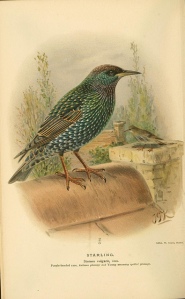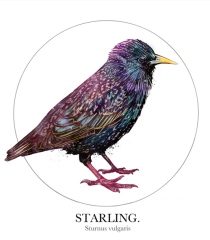I suppose I should start this blog with an introduction of sorts. Hello! This is a blog I’ve just started up to share my life-long love of nature and wildlife. It’s not exactly the coolest thing for a 21-year-old to be writing about, and like most people whilst a mildly embarrassing hobby I completely blame my upbringing. My father, a maths teacher by trade, was a true naturalist at heart, and his influence, combined with a heavy dose of Ted Hughes and the Romantics from my English-teacher mother, meant that my childhood self forsook Barbie dolls and real friends for a life of fishing, bird-watching and spider-hunting. Whilst the spiders and I haven’t really seen eye-to-eye since one rudely ran up my sleeve when I was ten, my love of nature and the great outdoors has continued throughout my life. For me, being able to understand and interact with a world beyond the confines of human construction is a great gift. I moved to London last September and am slowly learning to cope with the dearth of green here by exploring the city’s parks and gardens and writing about them whenever I can. I also love literature, writing, and art.
For my first post, I thought I’d introduce one of my favourite birds; the starling (Sturnus vulgaris). I was going to save this one for a bit later, but a lovely I story heard today changed my mind, and pushed this little bird to the front of my th0ughts.
 The New Yorker Eugene Schieffelin is famous to many for introducing starlings to North America: he released sixty starlings into Central Park in 1890, and another forty in 1891. The birds, tough cookies as they are, were hardier than any other species Schieffelin tried to introduce: his attempts with bullfinches, chaffinches, nightingales and skylarks all led to nothing (except a lot of dead birds in New York). Perhaps a pretty boring story so far. But, his reason behind the release is, I think, really touching in its simplicity: he wanted Americans to hear and see every bird mentioned in the works of William Shakespeare. For Schieffelin, the starling, who we often dismiss as a nuisance, or overlook in it ubiquity, was a way to match ideas of literature and science, and to bring the stories of Shakespeare alive.
The New Yorker Eugene Schieffelin is famous to many for introducing starlings to North America: he released sixty starlings into Central Park in 1890, and another forty in 1891. The birds, tough cookies as they are, were hardier than any other species Schieffelin tried to introduce: his attempts with bullfinches, chaffinches, nightingales and skylarks all led to nothing (except a lot of dead birds in New York). Perhaps a pretty boring story so far. But, his reason behind the release is, I think, really touching in its simplicity: he wanted Americans to hear and see every bird mentioned in the works of William Shakespeare. For Schieffelin, the starling, who we often dismiss as a nuisance, or overlook in it ubiquity, was a way to match ideas of literature and science, and to bring the stories of Shakespeare alive.
How can you spot a starling? Well, luckily its looks take after its name – look for a bird whose plumage reminds you of a beautiful night sky, nourishingly deep and full of stars. There’s your starling! If starlings weren’t so numerous, I’m convinced it would be treasured exotic. Its plumage shines with green, blue, purple and turquoise when it catches the light, and it is a dazzling flier. The female of the species is not so pretty – they are plain, brown birds and a little smaller. But all starlings are brilliant mimics – it has 15-20 imitations of other bird calls, and has even been known to imitate phones ringing and car engines. There are also local dialects of imitations, which is such an odd thought!
Yet for all its beauty and intelligence, the starling is a bit of a yob. It will push smaller birds out of its way to get food, and chuck seed around before it eats it. Starlings’ nests are just as messy, often being just a jumble of twigs and grass. They are very noisy neighbours, too – the female will choose the male with the loudest and most complicated song for a mate, and even when they flock together, the synchronised movement of their wings makes a ‘whoosh’ sound loud enough to be heard hundreds of miles away.
 Starlings are one of my personal favourites for their pretty plumage and flock displays, which pull and gather in the sky like great elastic clouds. I befriended one in my first year of university, which has given me a real fondness for them (sounds like the start of a Pixar movie, right?). I was allocated a ground floor room in the spring term which overlooked a patch of land at the back of the college; a green lawn protruded by an oak tree that sprung up like a wizened finger and hushed the surroundings into soft quiet. My Dad, a life-long naturalist, used to send me big bags of bird seed in the post to feed the birds out of my window, which, painfully uncool as it seemed to my peers, I took great delight in doing. All sorts of birds would gather around my window like a circus of old friends – blackbirds, sparrows, blue tits and robins would weave ribbon paths around the shape of the old oak. But they were very shy and always kept their distance from me – except for one, a starling. After a few weeks this little one began to really trust me (or became increasingly desperate in his quest for food, who knows), and would perch on my thumb to eat seed from my hand. When some of the trees nearby blossomed, petals became his favourite food – they were like chocolate to him! So, they have been one of my favourite birds ever since.
Starlings are one of my personal favourites for their pretty plumage and flock displays, which pull and gather in the sky like great elastic clouds. I befriended one in my first year of university, which has given me a real fondness for them (sounds like the start of a Pixar movie, right?). I was allocated a ground floor room in the spring term which overlooked a patch of land at the back of the college; a green lawn protruded by an oak tree that sprung up like a wizened finger and hushed the surroundings into soft quiet. My Dad, a life-long naturalist, used to send me big bags of bird seed in the post to feed the birds out of my window, which, painfully uncool as it seemed to my peers, I took great delight in doing. All sorts of birds would gather around my window like a circus of old friends – blackbirds, sparrows, blue tits and robins would weave ribbon paths around the shape of the old oak. But they were very shy and always kept their distance from me – except for one, a starling. After a few weeks this little one began to really trust me (or became increasingly desperate in his quest for food, who knows), and would perch on my thumb to eat seed from my hand. When some of the trees nearby blossomed, petals became his favourite food – they were like chocolate to him! So, they have been one of my favourite birds ever since.